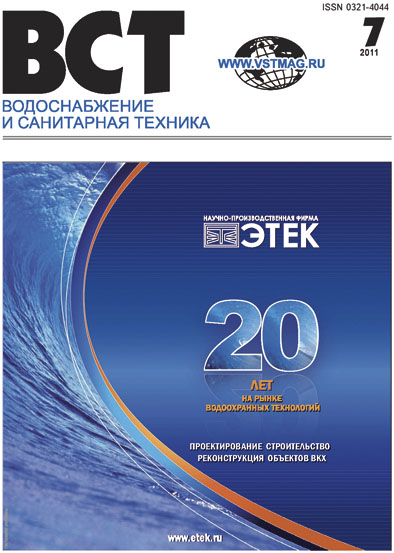|

Number 7 / 2011
To download all number in format PDF (in Russian)(pdf)
Number maintenance (pdf) (doc)
Number abstract (doc)
Literature lists to articles (doc)
|
bbk 000000
UDC
St. Petersburg Нas Left the List of Polluters of the Baltic Sea
|
bbk 000000
UDC 628.1/.2.001.2
Pupyrev E. I.
Features of Designing of Water Supply and Wastewater Disposal Systems in Russia
Summary
Modernization of water supply and wastewater disposal systems in Russia did not become a nation-wide problem. The Pure Water Program for realization of which 9 milliard roubles were allocated for 3 years after long discussions essentially failed. Development and modernization of regional systems of water supply and wastewater disposal are executed at the expense of own and borrowed funds of the operators of the water branch. It determines the specificity of designing of systems in Russia.
Key words
water supply , designing , sewerage , technical normalization , expertise of projects
|
bbk 000000
UDC
About Results of the Open Competition for a Prize of the MosvodokanalNIIproekt OJSC to Young Scientists and Engineers in the Field of Water Supply and Wastewater Disposal in 2011
|
bbk 000000
UDC 628.16(083.75)
Mazaev V. T., Shlepnina T. G.
Assessment of the Sanitary Hazard Degree of Silicon Compounds in Natural and Potable Water
Summary
The survey of literature on the role of silicon in the human body, its toxicokinetics is conducted; the critical analysis of scientific substantiation of hygienic standards of maximum concentration of silicon compounds in natural and potable water is made. The attention is paid to the absence of standards concerning the silicon content in water in the foreign standard specifications because of non-actuality of the problem. It is proposed to cancel the standard of limit content of silicon in the domestic normative base in connection with the absence of its proper reasonableness.
Key words
potable water , maximum permissible concentration , silicon , normative , hardness , salt-content
|
bbk 000000
UDC 628.1:628.147.22:620.197.3
KINEBAS A. K., NEFEDOVA E. D., Melnik E. A., Karmazinov F. V., Bekrenev A. V.
Choice of Reagent Technology of Anticorrosion Water Treatment for Water-Distributing Network of St. Petersburg
Summary
The secondary pollution of city water in St. Petersburg with iron is caused by the highly corrosive aggressiveness of the Neva’s water, the source of the city water supply. The methods of reducing this water parameter are considered. The technology of neutralization of corrosive aggressiveness based on the injection of calcium chloride and sodium carbonate into water treated has been chosen. The technology of stabilizing water treatment has been introduced at the Sestroretsk and Petrodvorets water supply stations of St. Petersburg.
Key words
potable water , corrosion aggressiveness of water , calcium chloride , sodium carbonate , dozing system , water stabilization
|
bbk 000000
UDC 628.16/.31.085
IVANOV A. S.
Determination of the Minimal Efficient Doze of UV-Irradiation
Summary
The process of study of water for optimal and valid choice of power of the ultraviolet irradiation system is described. The effectiveness of water treatment by ultraviolet irradiation depending on the content of suspended particles in water is shown. A diagram of the dependence of performance of ultraviolet disinfection on the water transmission coefficient is presented. The necessity of conduction of the preliminary model ultraviolet irradiation and drawing up of the conclusion before the delivery of equipment to the real object of the customer is substantiated.
Key words
disinfection , ultraviolet , wastewater , water treatment , disinfection
|
bbk 000000
UDC 628.16/.31.085
Rudnikova G. I., Zelenin A. M.
Water Disinfection Using the UV-Irradiation at Water Treatment Facilities of the City of Angarsk
Summary
For the purpose of improving the barrier function with respect to viruses, parasites and water bacteria at water treatment facilities of Angarsk the station of potable water UV-disinfection was put into operation in 2009. The station’s equipment is located in the building of main facilities block before the vertical mixers. From the first days of operation the high efficiency of the UV-disinfection method was established. The analyses results show the complete inactivation of all water microorganisms and dependence of intensity of lamps radiation on physicochemical properties of river water as well. For the purpose of eliminating this dependence the alternative scheme of water feed is offered: treated water after the filter is delivered to UV-disinfection plants instead of river water.
Key words
potable water , chlorination , turbidity , ultra-violet disinfecting , water treatment , microorganisms , inactivation
|
bbk 000000
UDC 625.768.5:628.311
Alekseev M. I.
Calculation of Discharge and Volume of Snowmelt Runoff from Urbanized Territories
Summary
In some cases the discharges and daily volumes of snowmelt runoff from urbanized territories may exceed the calculated values of rain water discharge from the runoff basin considered. The technical literature cites only the data on the maximum intensities or daily layers of snow melting of small probability (less than 50%), which corresponds to the period of a one-time exceeding over 1,5 years. At the same time, the rain networks are most often calculated for rains with a period of one-time intensity exceeding of 0,33–1 year. On the basis of data on probability distribution curves the most characteristic of snow melting, the values of daily layers of melted runoff at small periods of intensity exceeding are obtained.
Key words
rain and melt waters , intensity of snow melting , security , hydrograph of runoff , discharge and volume of melt water
|
|